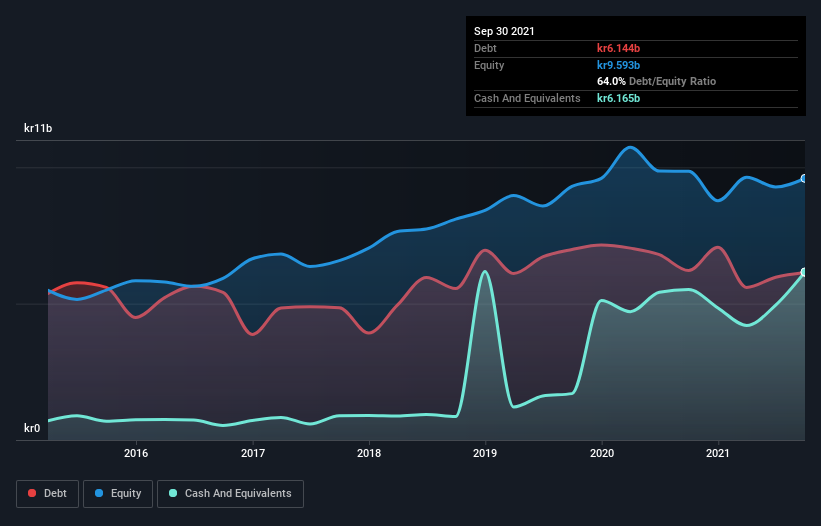
Warren Buffett famously said, 'Volatility is far from synonymous with risk.' When we think about how risky a company is, we always like to look at its use of debt, since debt overload can lead to ruin. Importantly, Loomis AB (publ) (STO:LOOMIS) does carry debt. But is this debt a concern to shareholders?
What Risk Does Debt Bring?
Generally speaking, debt only becomes a real problem when a company can't easily pay it off, either by raising capital or with its own cash flow. Part and parcel of capitalism is the process of 'creative destruction' where failed businesses are mercilessly liquidated by their bankers. However, a more frequent (but still costly) occurrence is where a company must issue shares at bargain-basement prices, permanently diluting shareholders, just to shore up its balance sheet. Of course, the upside of debt is that it often represents cheap capital, especially when it replaces dilution in a company with the ability to reinvest at high rates of return. The first step when considering a company's debt levels is to consider its cash and debt together.
View our latest analysis for Loomis
How Much Debt Does Loomis Carry?
The chart below, which you can click on for greater detail, shows that Loomis had kr6.14b in debt in September 2021; about the same as the year before. But it also has kr6.17b in cash to offset that, meaning it has kr21.0m net cash.

How Healthy Is Loomis' Balance Sheet?
The latest balance sheet data shows that Loomis had liabilities of kr9.26b due within a year, and liabilities of kr8.98b falling due after that. Offsetting this, it had kr6.17b in cash and kr3.27b in receivables that were due within 12 months. So its liabilities outweigh the sum of its cash and (near-term) receivables by kr8.80b.
While this might seem like a lot, it is not so bad since Loomis has a market capitalization of kr18.3b, and so it could probably strengthen its balance sheet by raising capital if it needed to. However, it is still worthwhile taking a close look at its ability to pay off debt. While it does have liabilities worth noting, Loomis also has more cash than debt, so we're pretty confident it can manage its debt safely.
But the other side of the story is that Loomis saw its EBIT decline by 9.8% over the last year. That sort of decline, if sustained, will obviously make debt harder to handle. The balance sheet is clearly the area to focus on when you are analysing debt. But it is future earnings, more than anything, that will determine Loomis's ability to maintain a healthy balance sheet going forward. So if you want to see what the professionals think, you might find this free report on analyst profit forecasts to be interesting.
Finally, a company can only pay off debt with cold hard cash, not accounting profits. Loomis may have net cash on the balance sheet, but it is still interesting to look at how well the business converts its earnings before interest and tax (EBIT) to free cash flow, because that will influence both its need for, and its capacity to manage debt. Over the last three years, Loomis recorded free cash flow worth a fulsome 90% of its EBIT, which is stronger than we'd usually expect. That puts it in a very strong position to pay down debt.
Summing up
Although Loomis's balance sheet isn't particularly strong, due to the total liabilities, it is clearly positive to see that it has net cash of kr21.0m. And it impressed us with free cash flow of kr1.4b, being 90% of its EBIT. So we don't have any problem with Loomis's use of debt. The balance sheet is clearly the area to focus on when you are analysing debt. However, not all investment risk resides within the balance sheet - far from it. These risks can be hard to spot. Every company has them, and we've spotted 2 warning signs for Loomis you should know about.
At the end of the day, it's often better to focus on companies that are free from net debt. You can access our special list of such companies (all with a track record of profit growth). It's free.
New: AI Stock Screener & Alerts
Our new AI Stock Screener scans the market every day to uncover opportunities.
• Dividend Powerhouses (3%+ Yield)
• Undervalued Small Caps with Insider Buying
• High growth Tech and AI Companies
Or build your own from over 50 metrics.
Have feedback on this article? Concerned about the content? Get in touch with us directly. Alternatively, email editorial-team (at) simplywallst.com.
This article by Simply Wall St is general in nature. We provide commentary based on historical data and analyst forecasts only using an unbiased methodology and our articles are not intended to be financial advice. It does not constitute a recommendation to buy or sell any stock, and does not take account of your objectives, or your financial situation. We aim to bring you long-term focused analysis driven by fundamental data. Note that our analysis may not factor in the latest price-sensitive company announcements or qualitative material. Simply Wall St has no position in any stocks mentioned.
About OM:LOOMIS
Loomis
Provides solutions for the distribution, payments, handling, storage, and recycling of cash and other valuables.
Flawless balance sheet, good value and pays a dividend.
Similar Companies
Market Insights
Community Narratives



